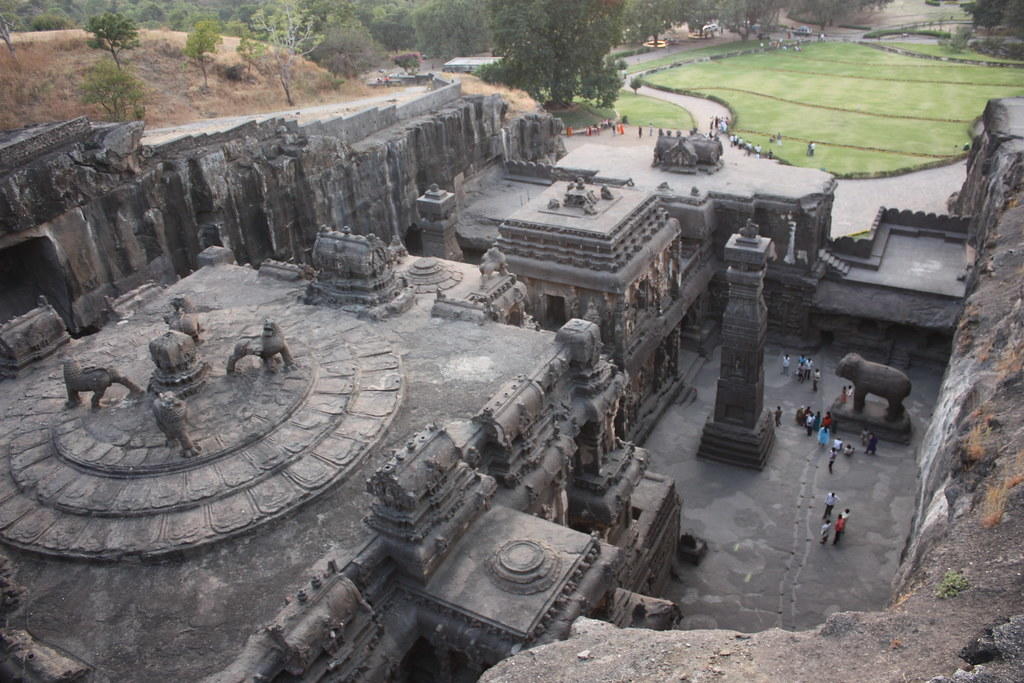Ellora, a sacred place in Maharastra, central India, is also known as Elura and Elapura. The Ellora Caves are renowned for their Hindu, Buddhist, and Jain temples and monuments that were chiselled out of the nearby cliff rock between the sixth and eighth centuries CE. They are recognized by UNESCO as World Heritage Sites. The most striking example is the 32-meter-tall Kailasa temple, the world's biggest rock-cut monument, which dates back to the eighth century CE.
Located a mile and a half into the Charnadari hills are the world-famous cave temples of Ellora. The ancient narrative of the three diverse faiths coexisting peacefully validates the monarchs' and people's perception of religion at that time. The Ellora caves comprise a collection of rock-hewn temples that signify the pinnacle of Western India's cave-temple construction. Three distinct Dharmic cultures are represented by these spectacular rock-cut temples, namely, Buddhism, Jainism, and Hinduism.
Discover the romantic history of the Taj Mahal.
The Ellora cave temples demonstrate how, during this Golden Age of human history, religious animosity gave way to kindness and response to reciprocity. The Ellora system of caves is strategically located at the intersection of the historic trade routes. The first trade route began in Bhrugukachha (Bharuch) and terminated in Pratishthana (modern-day Paithan). Conversely, the commercial path passed via Ajanta, Mahishmati, and Ujjain.

In terms of politics, economy, and society, the Ellora Caves have played a significant role. The place was formerly known as Ellapuram, which is where the word Ellora originates. Ellora is purportedly the anglicized form of the aforementioned. Ellora has even reached European and Arab nations. Travellers' reports highlight the caverns' splendour and abundance.

History of the Ellora Caves
The priceless collection of 34 caves at Ellora exemplifies a spirit of religious tolerance and coexistence through the exceptional architectural work of adherents of three major faiths. From the sixth to the twelfth centuries, there were three stages to the rock-cutting activity. Excavated between the 5th and 8th centuries, the earliest caves (caves 1–12) represent the Mahayana school of Buddhism that was then popular in this area. Between the seventh and tenth centuries, the Brahmanical set of caves (caves 13–29)—which includes the well-known Kailasa temple (cave 16)—were dug. In the final stage, which took place in the ninth and twelfth centuries, a series of caverns (caves 30-34) that reflected Jain philosophy were excavated.
Peek into the history of the Gateway of India and its importance for the British Empire.
Hindu Caves
Ellora is India's most significant second-wave site of ancient rock-cut architecture, situated in the Sahyadri hills close to Aurangabad. There are 35 caverns and rock-cut temples on the western slope of one hill made of volcanic basalt rock. These structures were primarily constructed in the sixth and seventh centuries CE, under the rule of the Kalachuri dynasty.
The Hindu Ramesvara cave (no. 21) is the oldest cave, dating to the sixth century CE. An inner sanctuary (garbhagriha), a circumambulatory passage for worshipers to go around, vestibules with double porticoes, and rich ornamentation featuring high-relief friezes and carvings illustrating scenes from the holy Purana books are features common to early Hindu temples.
River goddesses are engraved on the outside of Cave 21, there is a Nandi sculpture at the entrance, and inside are images of Durga fighting the buffalo demon king and a big dancing Shiva surrounded by musicians. The use of pair figures for brackets (salabhanjikas), elephant reliefs, and mithuna (lover) figurines are additional noteworthy features.
There may be a connection between Ellora and the Kalachuris because the Dhumar Lena cave (number 29) appears to be a duplicate of the well-known cave at Elephanta. There is more proof of a cultural connection between the two locations in the figure brackets of Cave 21. The cave known as Ravana-ka-Khai (number 14) was most likely devoted to a Hindu goddess. The inner sanctum is reached through a broad collonaded hall and walk-around hallway. Five relief panels that include images of Shiva and Vishnu and are divided by elaborate pilasters adorn the inner walls.
Learn the fascinating history of Charminar, Hyderabad's crowning jewel.
Kailasa Temple
The largest rock-cut edifice in the world, the Kailasa temple (number 16), is among the most breathtaking sites in the world. Constructed by Krsna I (r. 756-773 CE) of the Rashtrakuta dynasty, it further enhanced the splendour of Ellora, which was elevated to capital status by Dantidurga, Krsna's predecessor, after Krsna defeated the opposing Chalukyas in approximately 753 CE. Like the Kailasanatha in Kanchipuram, the Kailasa is the northernmost example of the southern Dravida temple style. It's a temple with five shrines or pancayatana.

Trace India's spiritual roots with a history of the Khajuraho temples.
Buddhist Caves
The Buddhist caverns are among the biggest that has ever been discovered. They were carved later than the Hindu ones, most likely in the seventh or eighth century CE. Their designs are more intricate, and the colonnades' capitals are either chamfered cushions or vases with vegetation. Cave 5 is very large and remarkably deep. It contains 17 cells and a big rectangular hall with 10 columns arranged in two rows separated by stone benches. Beyond the supposition that monks assembled there for meetings of some kind, the purpose of these is still unknown.
These caves' interior decorations feature images of the Buddha in several forms along with numerous Bodhisattvas, some of which are the oldest, like Tara. There are several inner sanctums with a Bodhisattva standing on either side. Four-armed figures have been shown to have Hindu influences; the oldest example of this type of carving is found in Cave 8.
Travel to India's seat of political power and unravel the history of the Red Fort.
The Visvakarma cave (number 10) contains one of the largest seated Buddha statues, while cave 12 is the most elaborate of the Buddhist caves. The latter cave, which was most likely excavated around 650 CE, has an incredibly spectacular two-level facade following a sizable open court area. A broad central chaitya window is situated over a veranda that is adorned with four columns, representing the ground floor.
There are deep, beautifully carved niches and relief panels on either side of this window, which leads to an internal gallery with a barrel-vaulted ceiling. Ultimately, the Dasavatara cave (number 15) is noteworthy because it has the only noteworthy ancient inscription, which in this case describes a visit by the local ruler Rastrakuta Dantidurga sometime between 730 and 755 CE.
Travel back in time to the majestic Konark Sun Temple in Odisha.
Jain Caves
Further details about patronage and the internal development of the site can be found in the Jain caves of Ellora. At the site's northernmost point are five Jain caves, known as Caves 30 through 34. The painted and sculpted programs include the Jain figure Bahubali along with Jinas, and Jain deities (especially those related to plenty, riches, and health).
Bahubali is usually shown in Ellora reliefs with two female figures flanking him, tending to the vines that encircle his legs. Flying, celestial lovers are seen overhead, holding long garlands of flowers in respect and devotion to Bahubali, who has recently acquired omniscience as a result of his unwavering meditation. The vines and the little deer that congregate around his feet allude to the event's forest environment.
There is evidence that Jain's artistic work began considerably earlier, even though the majority of Ellora's Jain caves were carved in the ninth and tenth centuries. This is visible in the style of pillars carved in Cave 33's upper-story veranda. These pillars resemble those carved in several of the early Shaiva and Buddhist caves at the site, with their fluted, cushion-shaped capitals and tall, plain shafts. Three Jina figures carved next to Cave 33 confirm an earlier date for the start of Jain activity.
Discover the towering glory that is the Qutab Minar through a historical lens.
These Jinas are supported on throne bases with a cloth or fabric covering the center portion of the base that falls downward. A double lotus seat that aesthetically supports the Jina is carved above the fabric. Similar designs can be seen on the thrones at the location that holds some of the Buddhas. These factors, together with others, point to the beginning of Jain activity around the seventh or early eighth century. This is important because it shows that groups of artists were concurrently working on Buddhist, Jain, and Hindu caves during this time.
Ellora Caves: Tourist Information

The Ellora Caves are open from dawn to dusk, that is, from 8 a.m. to 5:30 p.m. The Ellora Caves are closed on Tuesdays. You can spend the remainder of the week exploring the caves. November through March is the ideal time of year to visit Ellora Caves.
Revel in the history of the Ajanta Caves and celebrate India's cultural diversity.
Indian people must pay an entry fee of Rs 40 to enter Ellora Caves, and citizens of SAARC and BIMSTEC countries must also pay this amount. For overseas visitors, the entrance fee is Rs 600. Children under 15 do not need to pay an entrance fee to enter Ellora Caves. In addition, the tourist information center (which also has restaurants, shops, theaters, and parking) sells audio-visual guides.
Importance of the Ellora Caves
The Ellora ensemble is a singular work of art and a masterwork of human creative power. In terms of technological innovation, a monument like the Kailasa Temple is unmatched if one just looks at the labour-intensive rock excavation process. But this temple, which transposes models from "constructed" architecture, provides an encyclopedic program in addition to an amazing repertoire of highly plastic sculpted and painted shapes.
In addition to serving as a testament to the three major world religions—Buddhism, Brahmanism, and Jainism—the Ellora Caves also serve as an example of the tolerant nature of ancient India, which allowed these three faiths to establish their communities and sanctuaries in one location, thereby enhancing their universal significance. Ellora's unbroken sequence of monuments from AD 600 to 1000 revives the ancient Indian culture.















